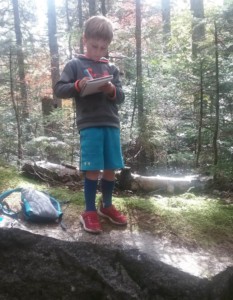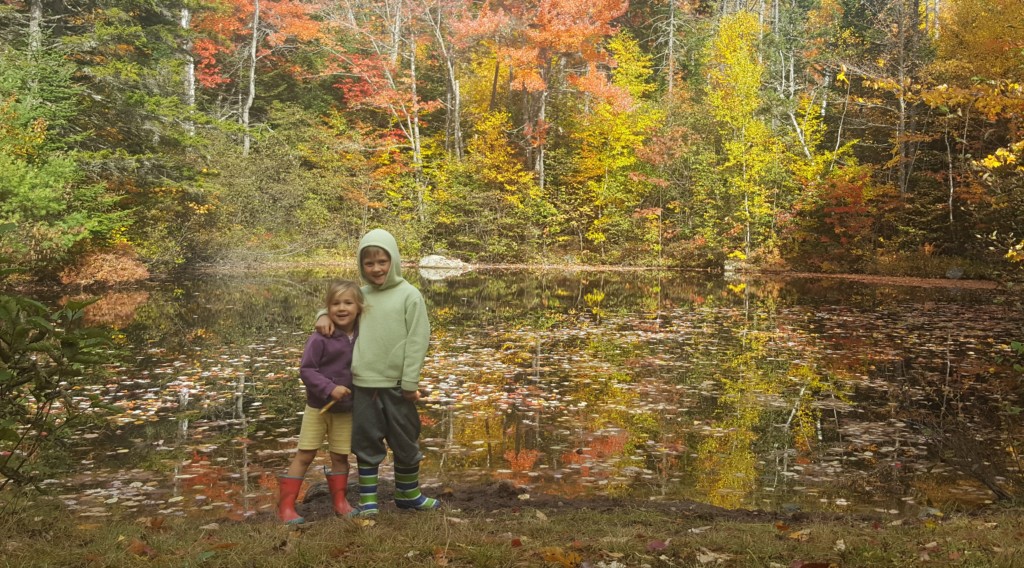
Activities for When the Family is Stuck at Home
While we are all fast becoming veterans of life at home and multi-tasking, it remains important to engage with each other and with the environment. The longer we stay safe at home, the more activities we run through. We update our activities regularly to stay relevant. Be well and get outside!
FALL ACTIVITIES
Seed Scavenger hunt
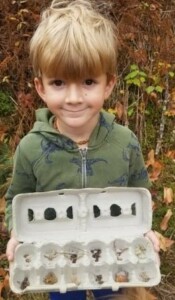
We take joy in the beauty of flowers in the summer, but the only purpose of a flower for a plant is to produce seeds (and thus more plants). Take an empty egg carton (or other container) and see how many different kinds of seeds you can find. How are each of the seeds transported to the new location that they will grow? In the wind? By animals? In the water?
Leaf Chromatography Experiment
There are three types of pigments that affect a leaf’s color: chlorophyll (green), carotenoid (yellow, orange, and brown), and anthocyanin (red). Chlorophyll and carotenoid are in the leaves all the time during the growing season, but in the summer the plants produce so much chlorophyll that most leaves only look green. As the days shorten, the plants make less chlorophyll so the other pigments are visible (hence the changing colors in the fall).
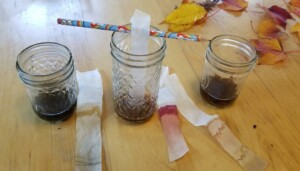
This experiment allows you to see the different pigments in the leaves.
- Collect a few leaves from the same type of tree.
- Tear leaves into small pieces and place them in a tall glass. Add enough alcohol to cover the leaves and cover the glass with plastic wrap to keep the alcohol from evaporating.
- Put the glass into a dish of hot water for about 30 minutes. The pigments from the leaves should be released into the alcohol.
- Place a filter paper strip in the glass, so it is barely touching the alcohol.
- Some of the mixture will slowly travel up the paper and after 30-90 minutes you will see bands of the different pigments that were in your leaf. The longer you leave it in the alcohol, the more pigment will travel up filter paper.
Acorn Hunt
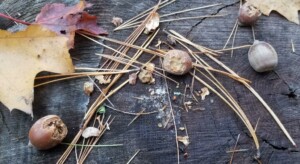
So far this fall, it has felt like you should be wearing a hard hat when you go into the woods to protect yourself from the falling acorns. According to the Farmers’ Almanac, an abundance of acorns is a sign that it is going to be a particularly harsh winter. The actual reasons and methods for some years being high mast years (lots of acorns) and some not is still unknown to scientists.
What we do know is that acorns provide a lot of the energy to fuel the food chain in the northern forests. See how many acorns you can find that have been munched on by animals.
Leaf prints
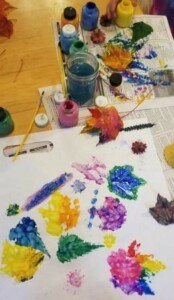
Whether you want to make a field guide or a piece of art, all this takes is paper, a little paint, and a few leaves.
MID SPRING ACTIVITIES
Alone Walk
T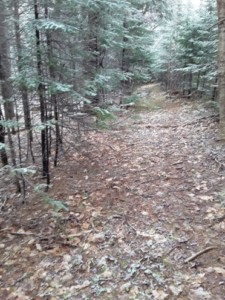 his is something your family might already do, but I’ll suggest it can be very powerful if we try it with intention (and, yes, attention). As my group walks together in the woods chatting, etc, we’ll sometimes stop and agree to an Alone Walk. Then we resume walking, but spaced 40 or 50 feet apart, each of us just barely able to see the person ahead of us on the trail most of the time. We each have to avoid the temptation to try to catch up! The leader stops, of course, at any trail junctions or other tricky spots. It can last 5 minutes or half an hour. That’s pretty much it. Its power is its simplicity – while doing this, many people discover a comfort and wonder with nature that they didn’t know was in in them. Some kids want to do it again and again.
his is something your family might already do, but I’ll suggest it can be very powerful if we try it with intention (and, yes, attention). As my group walks together in the woods chatting, etc, we’ll sometimes stop and agree to an Alone Walk. Then we resume walking, but spaced 40 or 50 feet apart, each of us just barely able to see the person ahead of us on the trail most of the time. We each have to avoid the temptation to try to catch up! The leader stops, of course, at any trail junctions or other tricky spots. It can last 5 minutes or half an hour. That’s pretty much it. Its power is its simplicity – while doing this, many people discover a comfort and wonder with nature that they didn’t know was in in them. Some kids want to do it again and again.
Alone Walk with Messages (AKA Burma Shave)
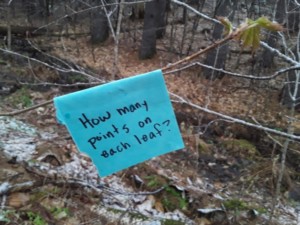 This is the Alone Walk with frills. It requires some set up ahead of time and also walkers who are readers. Setting up, I walk the section of trail myself with a little stack of index cards, a marker and maybe some clothespins or similar clip. With my child-eyed curiosity turned up high, I leave short, fairly open ended messages for those who will follow: “How many shades of brown do you see?” or “Don’t shake the spider web.” Or “Look under two rocks.” Or “How many petals on this yellow flower?” The clothespins or small stones might keep your notes from blowing away. Sometimes it is fun to backtrack the walk together, talking over what was noticed as you collect your notes. It seems to me that older kids would love to set up such a walk for others.
This is the Alone Walk with frills. It requires some set up ahead of time and also walkers who are readers. Setting up, I walk the section of trail myself with a little stack of index cards, a marker and maybe some clothespins or similar clip. With my child-eyed curiosity turned up high, I leave short, fairly open ended messages for those who will follow: “How many shades of brown do you see?” or “Don’t shake the spider web.” Or “Look under two rocks.” Or “How many petals on this yellow flower?” The clothespins or small stones might keep your notes from blowing away. Sometimes it is fun to backtrack the walk together, talking over what was noticed as you collect your notes. It seems to me that older kids would love to set up such a walk for others.
Make a Map
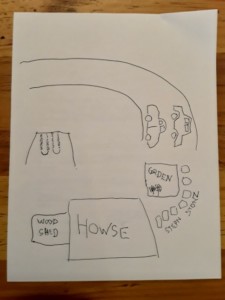 When I taught kindergarten, my students needed only small encouragement to make maps. We started by using blocks to map our classroom: “if this rectangle of blocks forms the walls of our room, and here is the door, how will we show the table?” They quickly moved to paper and crayons as they tried to show more and more detail. Third graders can start to really manage maps drawn to scale. “In real life the house is twice as long as the swingset, I’ll try to show that on my map.” Lots of fun: hide treats for one another and make treasure maps to exchange.
When I taught kindergarten, my students needed only small encouragement to make maps. We started by using blocks to map our classroom: “if this rectangle of blocks forms the walls of our room, and here is the door, how will we show the table?” They quickly moved to paper and crayons as they tried to show more and more detail. Third graders can start to really manage maps drawn to scale. “In real life the house is twice as long as the swingset, I’ll try to show that on my map.” Lots of fun: hide treats for one another and make treasure maps to exchange.
Night Walk/Sit
We all know the feeling of walking out the door in the dark to find our yard quite different than it was in day. Depending on how comfortable your kids are with the dark, I recommend starting somewhere familiar, just sitting. Take a flashlight, but try to keep it in your pocket – this is important. Your eyes grow accustomed to the low light and you feel surprise at how well you can see. Your other senses are alert. Plan ahead, knowing a wide trail or little used road. Whisper. Listen well. Night noises can be intense. In New England we are lucky that ours are all benign. If you search you’ll find various resources for learning identifying the calls of various frogs, owls, etc. Here is a link to a Youtube playlist of New England Night Sounds
EARLY SPRING ACTIVITIES
Cocoons And Other Pupal Cases
Many insects metamorphose from larva to adult within pupal cases of various sorts attached to twigs of trees and bushes. We see them around the bushy edges of the yard and on the twigs of saplings along every trail we explore. We see them when we dig a little into the garden soil. Sometimes you can tell that the adult has already emerged. Sometimes, there is a pinprick of a hole that likely means some even tinier creature has tunneled in and made a meal of the contents. Or the case has been torn open by a bird or raccoon. Other times the case is intact and worth watching some more. We might mark it with a ribbon (easy to find again) and remind each other to check it again and again. Or we might cut the twig and put it in a glass of water on the screened porch, where we’ll observe it through the weeks ahead. We worry that if we brought it indoors it would emerge before any of its food plants (and mates) were ready in the outdoor world.
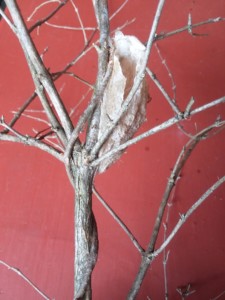
coccoon of a large moth
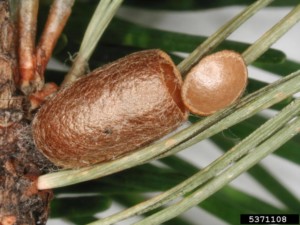
Pupa case of a sawfly (type of wasp).
Pooh Sticks
Winnie the Pooh thought he invented this game, although it is certainly as old as the world’s first bridge. I never cross a forest road bridge without playing a round or two. Everyone find a couple of sticks. Get to know your own. Long and peeled? Dark and curvy? Forked? ONE. TWO. THREE. Drop them into the current on the upstream side of the bridge and then move to the downstream side and watch to see which wins the race. Go find more sticks!
Branch Bouquets
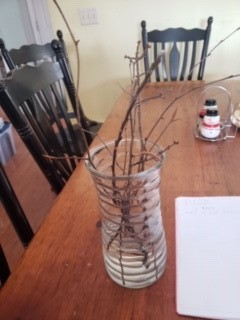
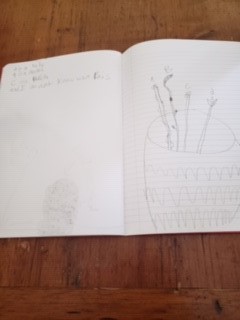
This is the perfect time of year to cut some twigs from deciduous trees and put them in water indoors. Make sure you get the springy live ones. These could be just six inches long or over two feet if you have a big vase and space where they won’t tip over. Set them up like a twiggy bouquet and add more water when needed. We like to cut some small branches from apple, cherry, maple – any live deciduous tree can work. Take a close look at the buds at the ends of each branch. Almost all buds are sheathed in a protective “scale” – sort of like a fish scale. Most are leaf buds, with all of the coming spring’s leaves in miniature, origamied there within. With luck you also have a few flower buds on your twigs. If you have branches from a variety of trees it is fun to compare when and how their little leaves unfurl. Make a sketch or two, before and after… and after after.
Stone Wall Histories
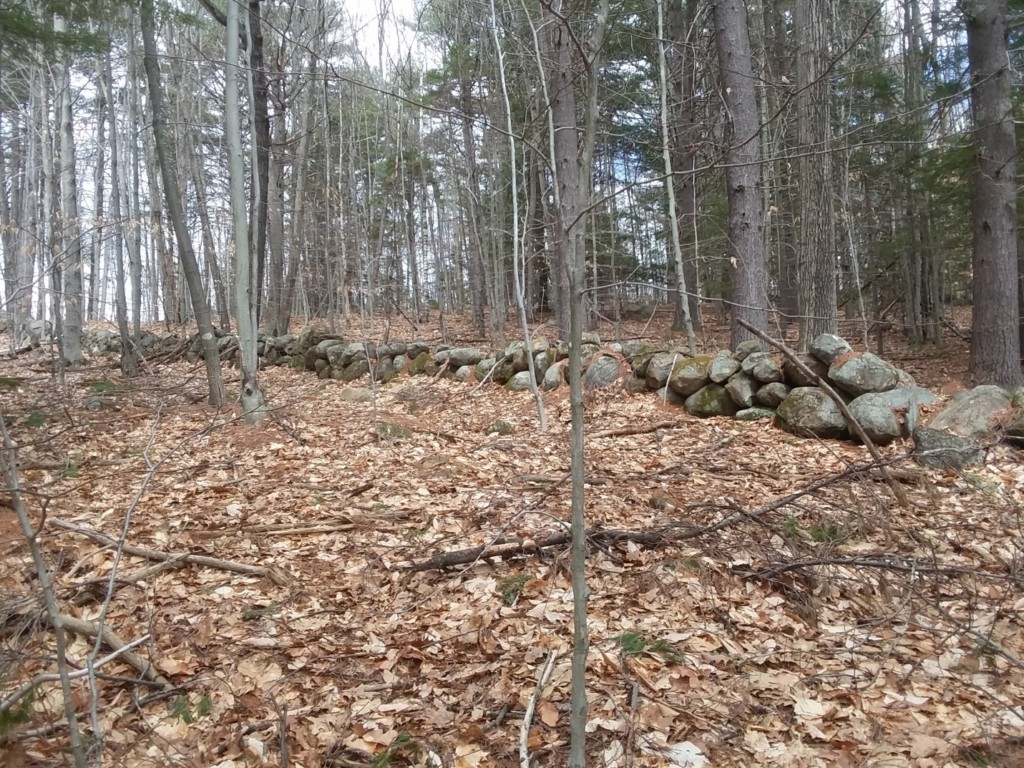
This Tamworth stone wall would likely have edged a sheep pasture
Early spring is the best time to see stone walls and cellar holes. You may be aware of some near you. Finding and following them can really be a means of time travel. Imagine the families of the early 1800s who spent countless days of work building these walls – you can bet these were more than boundary lines. The “single course” walls mostly enclosed sheep pastures. The wider walls, often a “double course” of large rocks with smaller stones filling the spaces between, would have enclosed crop fields or gardens. If you don’t know where to find these ask your town’s historical society, or the Upper Saco Valley Land Trust, or check out the great trails at Tin Mountain’s property in Jackson on Tin Mine Road.
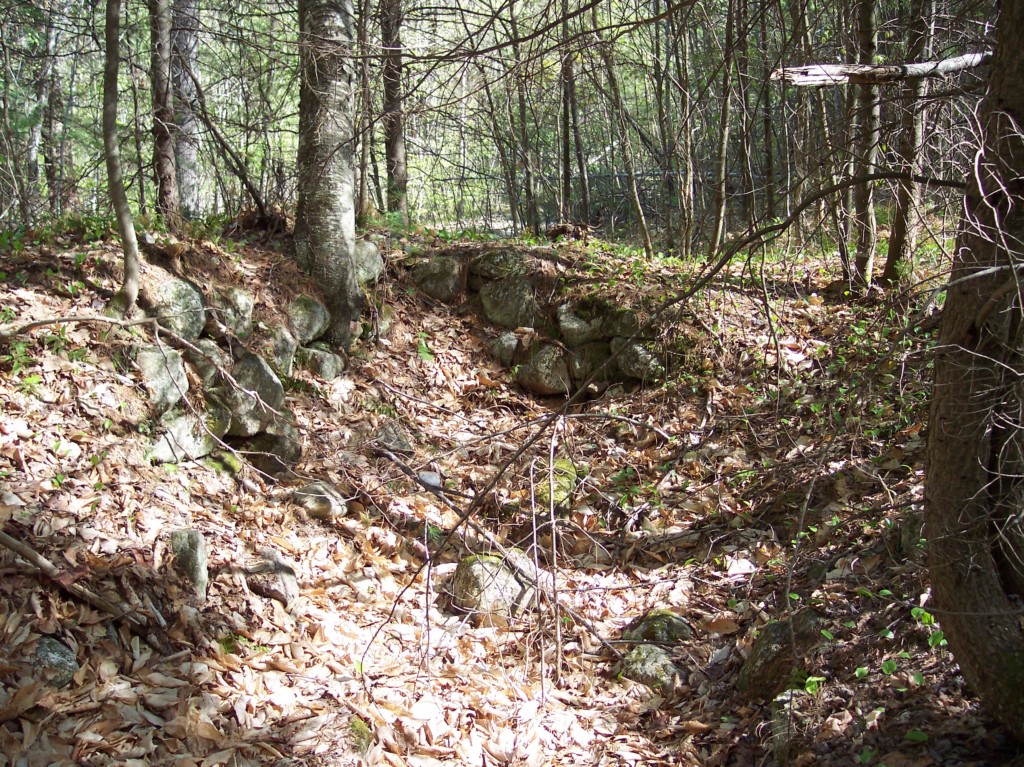
Cellar Hole off Shawtown Road in Freedom
You will also find cellar holes as you walk the old roads of most any New England town. Now most of these look like vaguely rectangular depressions in the forest floor, edged with stone walls. Most families constructed cellar holes on top of which to frame their wooden houses (which often had bigger footprints than the cellars). Before refrigeration, cellars like these were essential for cold, but not freezing storage of apples, potatoes and other produce. Many cellar holes had a substantial stone platform to support the house’s chimney. These stone works remain, while the chimney and house materials long since burned, rotted or were hauled away.
Nature Journaling
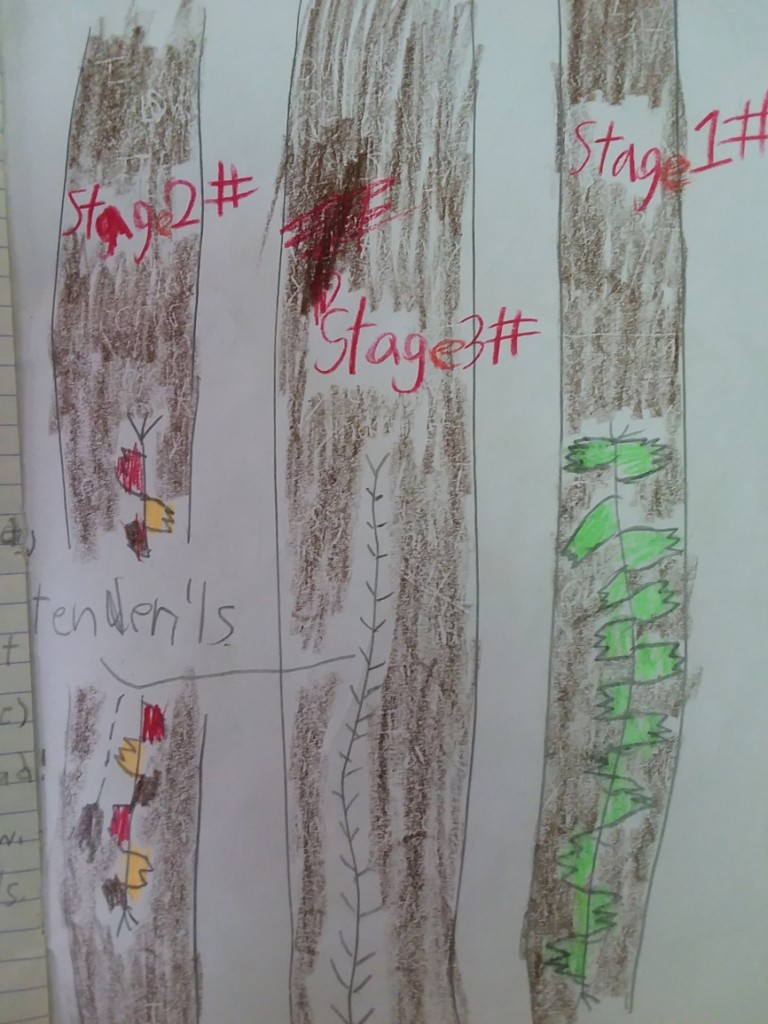
In this journal drawing a student drew a vine on a trunk and showed how it changed over several weeks.
My students and I love to record our observations in nature journals. We try to be as scientific as we can: noting date, time, weather and location. Then we describe our subject in detail – colors, textures, smells, relative size. We always include a labeled sketch. A favorite type is before-and-after style. The sky in the morning vs the sky in the afternoon. The daffodils today vs the daffodils on Friday. Etc.
